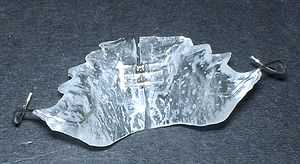Palatal expander

A palatal expander, also known as a rapid palatal expander, rapid maxillary expansion appliance, palate expander, orthodontic expander, Haas, or Hyrax, is used to widen the upper jaw so that the bottom and upper teeth will fit together better.[1][2] Although the use of an expander is most common in children it can be and has successfully been used in adults, although the effects of expansion are slightly more uncomfortable. Also, depending on the amount of correction, it may result in surgical separation of the top jaw. Use of a palatal expander is most often followed by braces to straighten out all the teeth now that room has been created.
The expansion process usually results in a large gap between the patient's 2 top front teeth, although this does not always happen. This gap is closed naturally and the teeth may overlap which leads to braces being needed. Sometimes with expanders, patients have to turn the expansion screw themselves to tighten up the expander. For expansion that is not managed by the patient and on the lower jaw, a bionator may be a more suitable alternative.
Although it may vary from person to person, most usually feel slight pressure on their teeth. As the patient turns the expansion screw using the key, a space develops between the front two teeth. Some may develop a large space while others do not develop a space at all. It usually takes a week or two for one to adjust to eating and speaking after first receiving the rapid palatal expander. Patients may experience pain and headaches while wearing palatal expanders and when the screw is turned. They may also feel a sore on their tongue from contact with the expander's metal bars.
Patients who have expanders may experience extra saliva and lisps[3] (pronouncing the letter s, t, and r blends become very difficult).
When the palatal expander is first removed, patients usually report that their mouth feels extremely big and spacious. After the patient's expander is removed they also have a large gap in their mouths.
They usually remain in the patient's mouth for about 9 weeks, but this time may vary.[4]
References
- ↑ Haas, A.J. (1965). "treatment of maxillary deficiency by opening the mid palatal suture". Angle Orthod. 35. pp. 200–217.
- ↑ Angle, E.H. (1860). "Treatment of irregularity of the permanent or adult teeth". Dent. Cosmos. 1. pp. 540–544.
- ↑ Stevens, Kyle; Bressmann, Tim; Gong, Siew-Ging; Tompson, Bryan D. (2011). "Impact of a rapid palatal expander on speech articulation". Am J Orthod Dentofacial Orthop 140 (2). pp. 67–75. doi:10.1016/j.ajodo.2011.02.017. Retrieved 2015-02-17.
- ↑ Umasankar, K.; Umasankar, Nagalakshmi (2001). "Palatal Expanders in the Correction of Bilateral Posterior Crossbite - Which one, When & How?". J Ind Orthod Soc 34. pp. 107–113. Retrieved 2015-02-17.
| ||||||||||||||||||||||||||||||||||||||||||||||||||||||||||||||